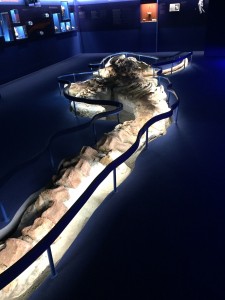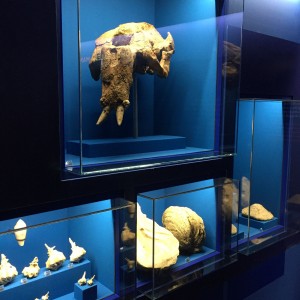“Tales of the Whale” at the University of Florence Natural History Museum Paleontology
By Rachyl Grussing (Istituto Lorenzo de’ Medici)
In May of 2016 the University of Florence Museum of Natural History Paleontology department unveiled a new permanent exhibit. ‘Tales of a Whale’ is dedicated to one of the most important specimens in their collection, a three million year old Pliocene fossilized whale skeleton that was found in a field near Orciano Pisano, a small town in the foothills of Tuscany. The museum uses the specimen to illustrate life at the bottom of the sea floor during the time of the whale, and makes connections to things that are still alive today.
As the main attraction, the three million year old skeleton enjoys a place of honor directly in the center of the room. Guard rails act as lights, both outlining the skeleton and informing visitors of where not to step. Three walls act as context for the whale, holding shells, smaller fossilized fish, crustaceans, and plant life that would have surrounded the body of the whale on the seafloor and also details what species of these animals are still alive today.
A film projected onto the walls above the display cases details the discovery of the whale skeleton and the different cultures that would have hunted the whale in ancient times, featuring interviews from different professionals from sections of the Natural History Museum. The museum has also reached out to other sections of the Natural History Museum, namely La Specola and the Anthropology section, to borrow different species of taxidermied birds that would have flown with the whale, and different Inuit tribal items, spears and clothing, from cultures that hunted the whale. The exhibit details how the whale was hunted and how it was killed, and what the tribe would have done with the whale carcass.
The fourth wall of the room holds two levels of plush seating for visitors to sit and enjoy a short documentary on the finding of the whale, or simply enjoy the atmosphere. There are also interactive elements on the walls in the form of push drawers and goggles that allow the visitor to immerse themselves fully into the experience. At a pillar bisecting the seats are headphones for the curious visitor to listen to the video. If all six headsets are taken, the two screens display both English and Italian subtitles. The seats allow the visitor to either watch the video or simply suspend belief and fully engage in the underwater experience.
The exhibit is an experience in the best way; with deep blue colors, soft lighting, and brightly colored label text, it is designed to mimic the sea floor as it would have been several million years ago, and instead of feeling claustrophobic, the room feels expansive. The visitor is tossed into the world of the whale, and it engages them in an atmosphere that gives the impression of living and swimming deep underwater with the creatures on display.
Lights, sounds, and projections enhance the experience, allowing the visitor to learn more about what life would have been like at the bottom of the ocean long ago. All in all, this exhibition is extremely well done. The two-person staff of the Natural History Museum Paleontology should be commended for their excellent use of technology to create atmosphere and their impressive, detailed knowledge of all things whale-related.
Traduzione di Tania Mio Bertolo (Università degli Studi di Firenze)
Nel maggio 2016 la sezione Geologia e Panteologia del Museo di Storia Naturale dell’Università di Firenze ha inaugurato Storie di una balena, la nuova esposizione permanente dedicata ad uno dei più importanti esemplari della collezione: un fossile pliocenico di uno scheletro di balena risalente a tre miliardi di anni fa, ritrovato nei pressi del comune di Orciano Pisano nella pedemontana toscana. La musealizzazione di quest’esemplare ha fornito al Museo l’occasione per illustrare la vita nei fondali marini al tempo della balena, e ricercarne connessioni con la situazione attuale.
Come principale attrazione, lo scheletro occupa un posto d’onore direttamente al centro della stanza. Alcune transenne divisorie fungono da monito, utili sia a delimitare lo spazio occupato dallo scheletro sia a suggerire al visitatore la distanza di sicurezza. Ospitando gusci, piccoli pesci fossilizzati, crostacei e piante che probabilmente circondavano il corpo della balena nel fondale marino, tre pareti circostanti la carcassa ricreano il contesto acquatico originale, chiarendo anche quali tra queste specie sopravvivono ancor oggi.
Un video proiettato nelle pareti retrostanti gli esemplari esposti spiega il ritrovamento dello scheletro e, attraverso interviste ai diversi specialisti del Museo, avanza ipotesi circa le diverse civiltà che potrebbero aver anticamente cacciato la balena. Coinvolgendo anche altre sezioni del Museo come la Specola e la sezione di Antropolgia, la mostra espone diverse specie di uccelli tossidermizzati che potrebbero aver volato con la balena, e svariati simboli tribali, lance e vestiti appartenenti a civiltà passate che praticavano la caccia alle balene. La mostra chiarisce come la balena fu cacciata e uccisa, e cosa potrebbe essere avvenuto alla sua carcassa.
La quarta parete della stanza ospita due livelli di morbide poltrone, che invitano il visitatore ad accomodarsi per guardare il breve documentario inerente la caccia della balena, o semplicemente per godersi l’atmosfera. Ci sono inoltre elementi interattivi nelle pareti come pulsanti e occhiali che permettono al visitatore di immergersi completamente nell’esperienza. In alcune colonne collocate di fianco alle poltrone vi sono degli auricolari per quei visitatori che desiderano ascoltare l’audio del filmato. Se tuttavia i sei auricolari disponibili sono tutti in uso, due schermi mostrano sottotitoli sia in italiano che in inglese. Le poltrone permettono al visitatore sia di guardare il video sia di sospendere la mente e lasciarsi coinvolgere totalmente dall’esperienza subacquea.
La mostra è un’esperienza a tutti gli effetti: attraverso l’uso di colori come il blu profondo, luci soffuse e testi scorrevoli di toni accesi, essa è pensata per ricreare il sottofondo marino così come probabilmente era diversi milioni di anni fa, dando inoltre l’impressione di una dilatazione dello spazio piuttosto che di un ambiente claustrofobico. Il visitatore è catapultato nel mondo della balena, quasi invitato a vivere e nuotare sotto il livello dell’acqua con le specie riprodotte. Luci, suoni e proiezioni arricchiscono l’esperienza, permettendo al visitatore di imparare di più circa la vita negli antichi fondali marini. In conclusione questa mostra è veramente ben fatta, e lo staff della sezione Panteologia del Museo di Storia Naturale, composto da solo due persone, dovrebbe essere lodato per l’impressionante e dettagliata conoscenza di tutti gli aspetti della mostra.

